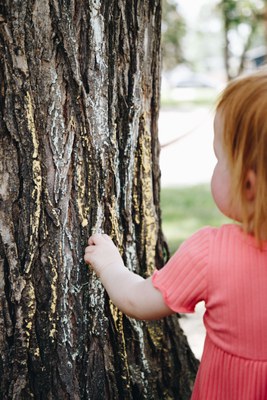TREE-mendous Summer Activities with Your Kids
Schools out for summer! For children, this is the best time of year, with endless opportunities for fun in the summer sun. But for parents, sometimes this can leave us wondering, “How am I going to keep my kids entertained all summer?” To that, I remind parents that you have the best jungle gym and classroom right in your own backyard: trees!
Trees benefit the health and wellbeing of all people, but they hold unique benefits for kids, especially when it comes to their development. Creating space for children to learn and play around trees helps them develop physical, social, emotional and personal skills. Trees engage all of their senses and spark their imagination.  Exploring natural environments (like climbing trees) develops problem-solving and risk-management skills, boosts confidence, and improves dexterity.
Exploring natural environments (like climbing trees) develops problem-solving and risk-management skills, boosts confidence, and improves dexterity.
Trees can improve the academic performance of children. They allow all kids to focus better and have even been reported to lessen symptoms of ADHD. Furthermore, kids who have access to green space, which includes trees, have better working memory and can experience an increase in their cognitive development. There have been studies that show students perform better on tests if they can even see green space from their classroom window; imagine the learning they can do this summer outside with you!
Trees can make our kids healthier too. They create a comfortable, shaded area where kids can play, which encourages physically active play. Children who live near trees have been found to be more physically active and have lower rates of obesity. It’s not just their physical health; trees benefit the mental health and wellbeing of kids, limiting stress and promoting relaxation in both children and adults.
There are many easy, fun activities you can do with your kids, while also teaching them about nature. Whether it’s in a park, a windbreak, or your very own backyard— take your kids out to explore around a tree. A Tree Rubbing Activity is a simple and creative way to help children learn about patterns and textures. It can also help children learn about the different parts and characteristics of trees as they complete their rubbings. Children will love the opportunity to go outside and practice a new art technique!
Have the child hold a piece of paper against the bark of a tree, then using a crayon, scribble back and forth to make the texture of the bark appear on the page. They can also do this with leaves, twigs, or any other part of the tree too! Have your kids compare the textures and patterns. How are they different? How are they similar? Did they get different patterns and textures from the same tree, or did the pattern remain the same? After you've discussed children's findings, take it further and turn the tree rubbings into abstract art to decorate your walls! Or grab sidewalk chalk and trace those ridges on the bark to make your trees even more colorful and fun.
Another activity is called a Rainbow Walk which utilizes investigating and sorting, essential skills for science and math. Attach paint chips or color blobs within a small box (six colors works best!). Encourage kids to take a walk around the trees, find an item that matches each color, and bring it back to put in the box. Children will find flowers, leaves, twigs, litter, or maybe even a bug to bring back from their Rainbow Walk. Have each child compare their collected items to each other.
Getting kids out into nature is one of the most meaningful things a parent can do to raise healthy, happy children. For more resources and ideas for connecting your kids to nature, visit the Project Learning Tree website at https://www.plt.org/activities-for-families/.
By Beth Hill, Outreach and Education Manager, North Dakota Forest Service



